Performing Backup and Recovery operations in CubeBackup for Microsoft 365
Backup overview
Central to the CubeBackup web console is the OVERVIEW page, which provides administrators with all essential information at a glance for the active organization. Here you can find the total data size in the backup, number of protected users and SharePoint sites, latest events, a graphical breakdown of app and user data, as well as license information and storage space status.

Restore
For the protection and security of your data, CubeBackup will NEVER overwrite current working versions. All restored data, whether OneDrive files or folders, Outlook Mail messages, People contacts, Calendar events, or SharePoint sites data, will be placed in a specially created folder named Restored <date-time> by default, and will NOT overwrite the current working data. This means you can safely restore any data to any version at any time without worry.
CubeBackup is designed to keep a version history of all of your data, including entire folder structures, making it easy to restore to an earlier point in time. For example, you can turn back the clock on an entire project, restoring all files and folders to the exact state they were in two months ago.
Restore Outlook Mail messages
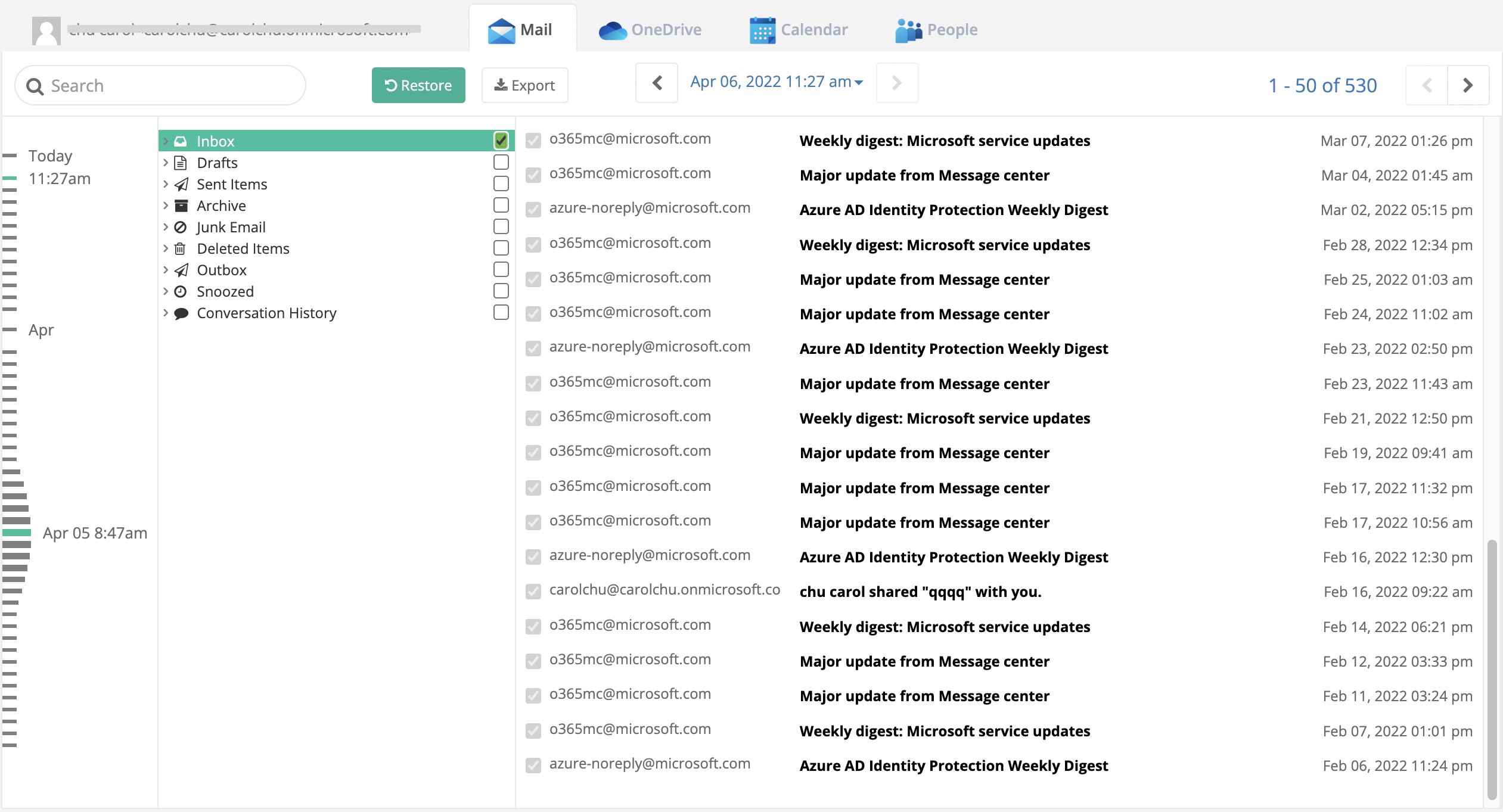
- Select Users from the left panel on the RESTORE page.
- Select the user whose data needs to be restored, using the search box if necessary.
- Click the Mail tab on the user restore page.
- To restore mail messages:
- Find the messages you want to restore. You can filter messages using the search box, or by browsing the Mail structure and the timeline in the left panel.
- Select the messages and folders you would like to restore.
- Click Restore.
- Select the account you'd like to restore the messages to and click Restore.
- CubeBackup will create a new folder in the user's mailbox that lists the date and time of restoration (i.e.: Restored 2022-04-06 10:15:02 am). You can also choose a specific target folder instead.
Restore OneDrive files or folders
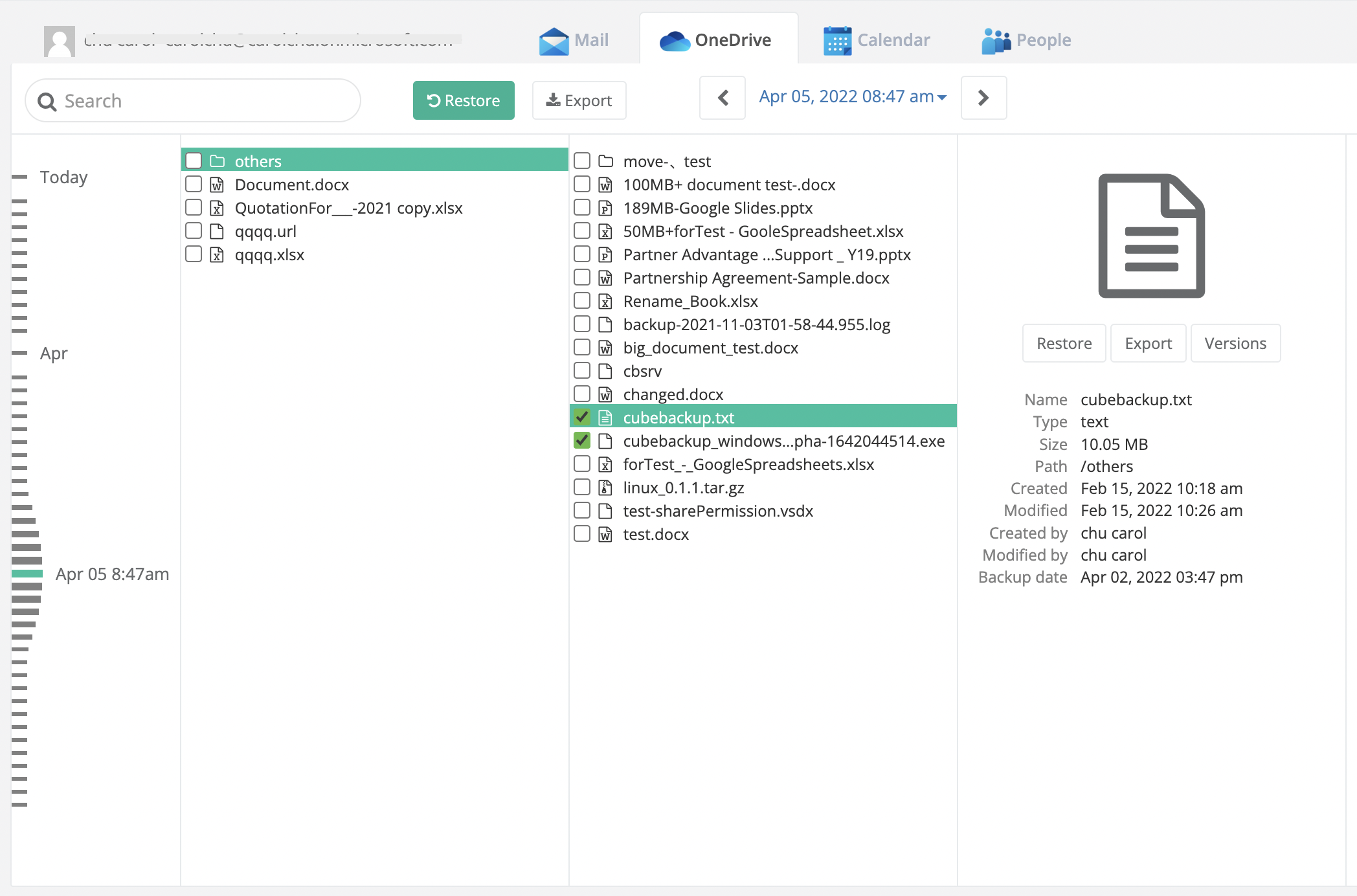
- Select Users from the left panel on the RESTORE page.
- Select the user whose data needs to be restored, using the search box if necessary.
- Click the OneDrive tab on the user restore page.
- To restore a single file:
- Find the file by browsing through the folder structure, or use the search box.
- Click on the file to display details, including filename, size, backup date, and other information.
- Click the Versions button to list all available revisions of the file.
- Select the version to restore and click Restore.
- Select the account you'd like to restore the file to and click Restore.
- To restore multiple files or folder:
- The timeline in the left panel shows the available snapshots, each representing the state of your entire OneDrive at that moment in time. Use the timeline to select the point in the version history you would like to return to.
- Select the files and folders you would like to restore, using the search box if necessary.
- Click Restore.
- Select the account you'd like to restore the files and folders to and click Restore.
- Restored OneDrive files and folders will be placed in a folder named Restored <date-time>. You can also choose a specific target folder instead.
Restore Outlook Calendar events
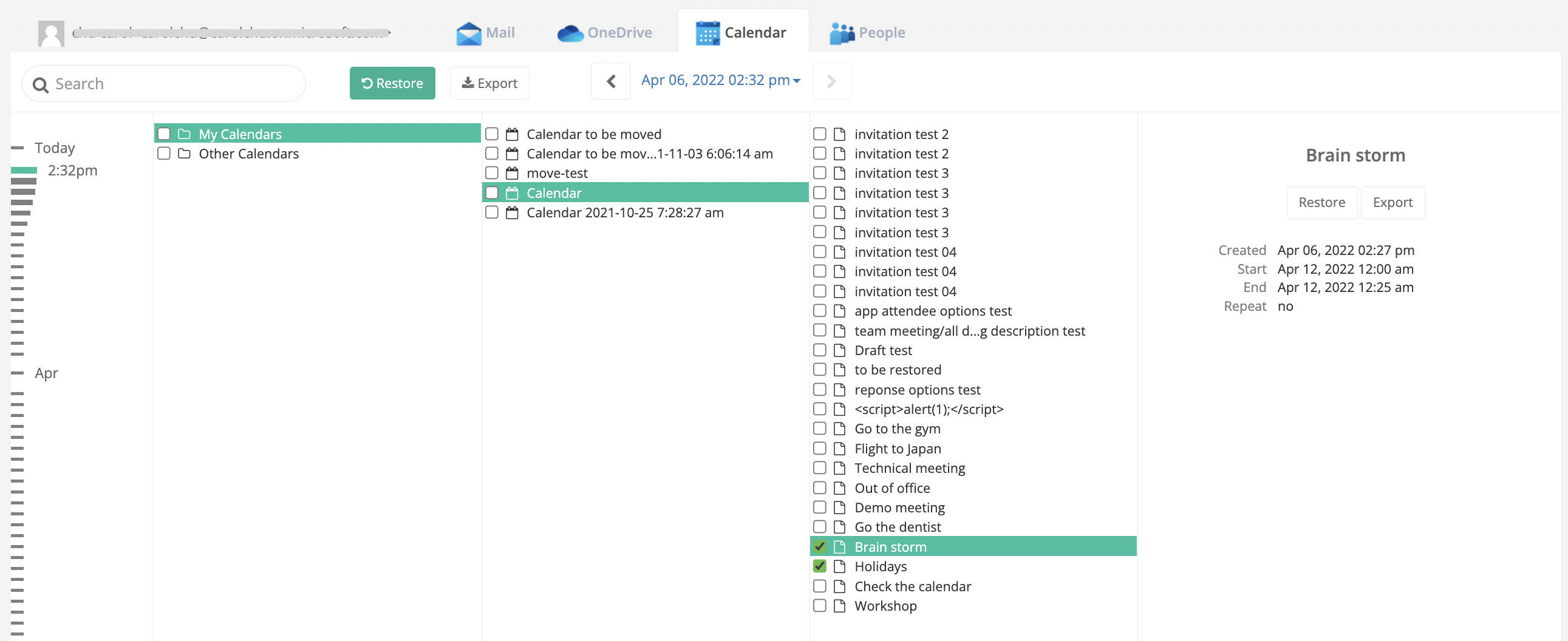
- Select Users from the left panel on the RESTORE page.
- Select the user whose data needs to be restored, using the search box if necessary.
- Click the Calendar tab on the user restore page.
- The timeline in the left panel shows the available snapshots, each representing the state of all Calendars belonging to that user at that moment in time. Use the timeline to select the point in the version history you would like to return to.
- Select the events or calendars you would like to restore, using the search box to find events, if necessary.
- Click Restore.
- Select the account you'd like to restore the events or calendars to and click Restore.
- Calendars/Events will be restored to the
Restored calendarsgroup.
Restore Outlook People contacts
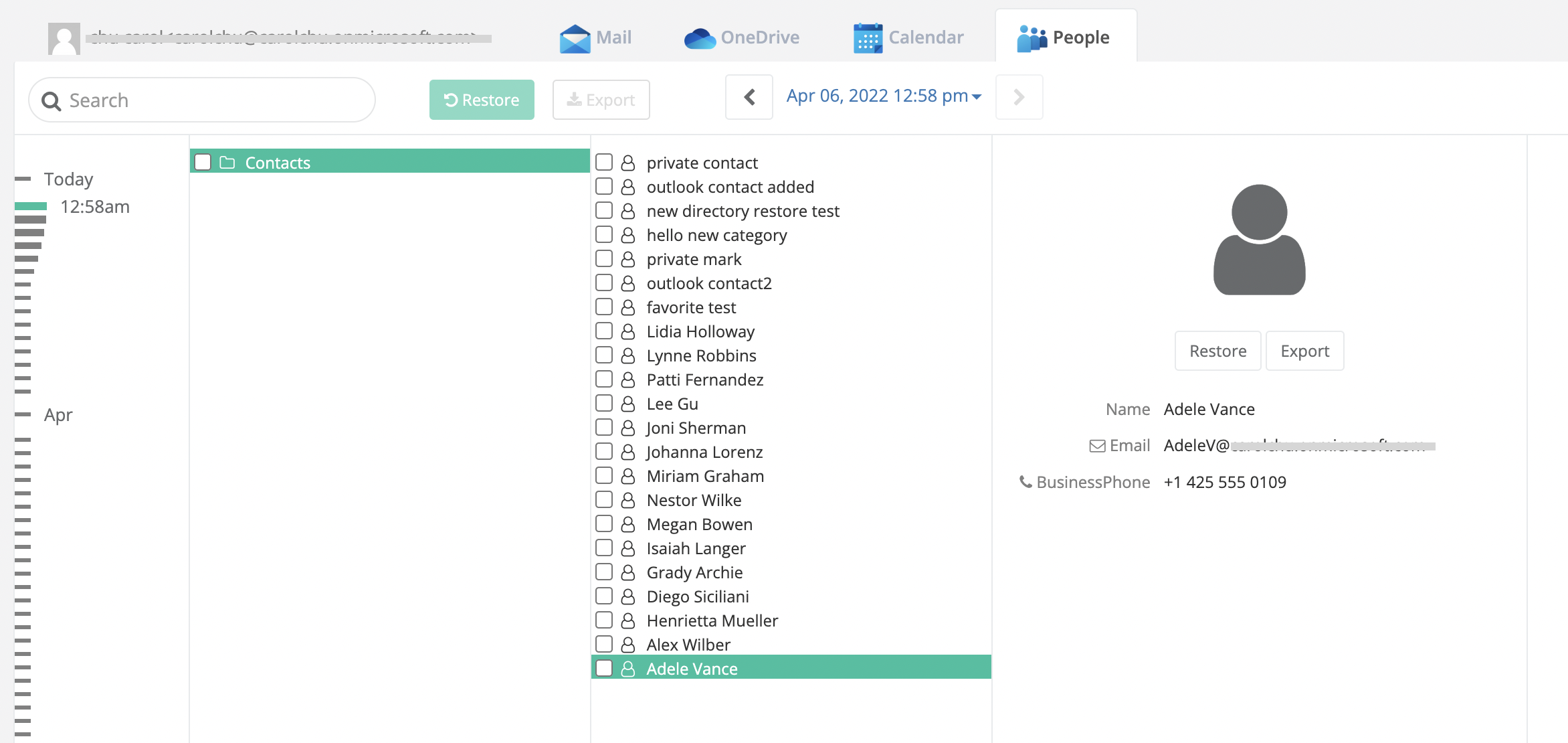
- Select Users from the left panel on the RESTORE page.
- Select the user whose data needs to be restored, using the search box if necessary.
- Click the People tab on the user restore page.
- The timeline in the left panel shows the available snapshots, each representing the state of your entire People contacts at that moment in time. Use the timeline to select the point in the version history you would like to return to.
- Select the contacts or groups you would like to restore, using the search box if necessary.
- Click Restore.
- Select the account you'd like to restore the contacts to and click Restore.
- Contacts restored to a user's Outlook account will have original categories preserved. By default, CubeBackup will also add a category that lists the date and time of restoration (i.e.: Restored 2023-08-11 10:15:02 am), or you can specify a target category instead.
Restore SharePoint sites
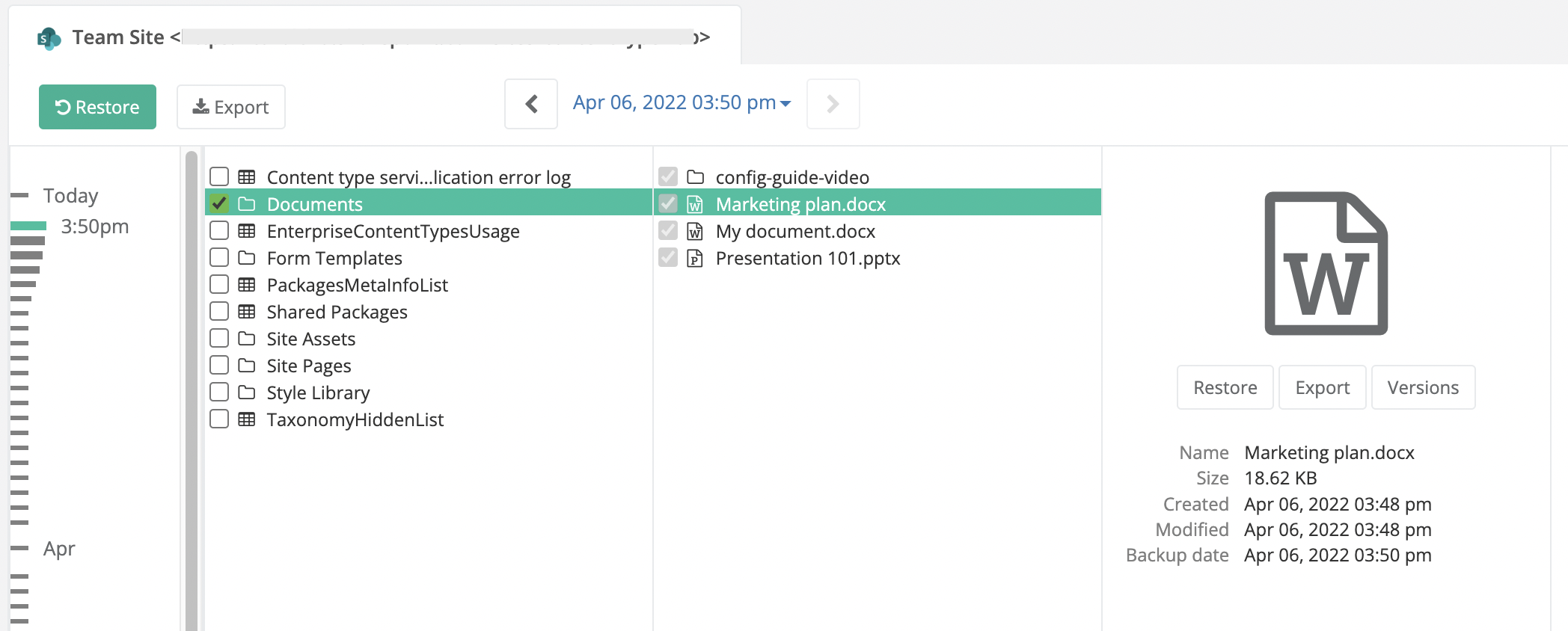
- Select SharePoint sites from the left panel on the RESTORE page.
- Select the site in which the data needs to be restored, using the search box if necessary.
- To restore a single file or list:
- Find the file or list by browsing through the site structure.
- Click on the file to display detailed information.
- Click the Versions button to list all available revisions of the file.
- Select the version to restore and click Restore.
- Select the site you'd like to restore the file or list to and click Restore.
- To restore multiple files or folders:
- The timeline in the left panel shows the available snapshots, each representing the state of the entire site at that moment in time. Use the timeline to select the point in the version history you would like to return to.
- Select the files and folders you would like to restore.
- Click Restore.
- Select the site you'd like to restore the files and folders to and click Restore.
- The restored lists will be created and named as Restored <date-time> <list-name> in the target site.
- The restored files and folders will be placed Restored <date-time> <document-library-name> document or page library in the target site. You can also restore to the original document library and choose a specific target folder instead.
View history
The HISTORY page displays the Backup, Restore and Export logs so you can easily monitor recent activities. Each time an action is performed, CubeBackup will add a log entry to this page. Separate tabs track entries for Backup, Restore, and Export actions.
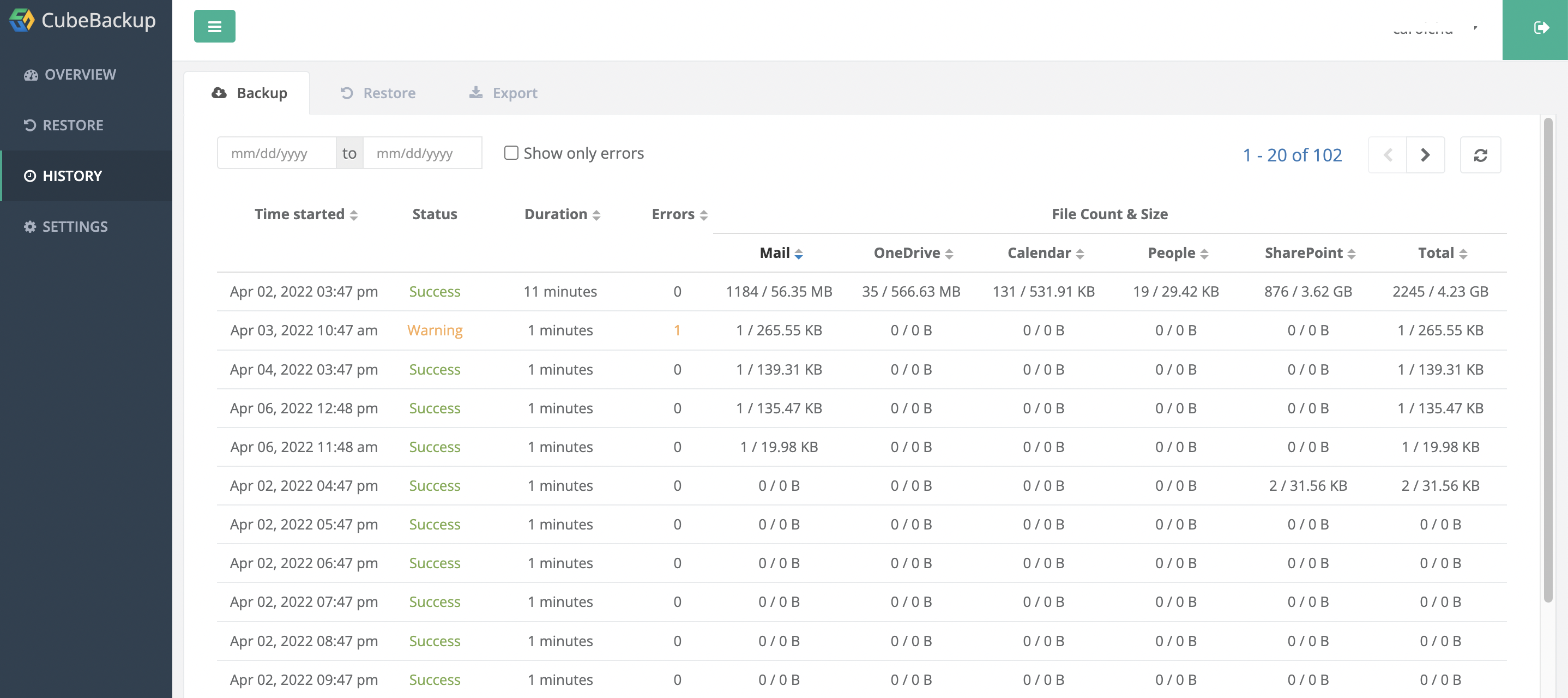
On the Backup tab, clicking on each individual backup entry will take you to another page listing information for all of the users and SharePoint sites that were part of that particular backup.
On the Restore and Export tabs, clicking the links under the Files column will open a pop-up window showing the individual items that were Restored or Exported for that entry.
The controls at the top of each tab can be used to filter the lists by description, date, or for a particular backup, by user/site.
Actions that have given an error will be highlighted in Warning in the list. The list can also be set to only display errors by clicking the Show only errors box. Clicking the Warning or Failed entry under Status or Errors will open a pop-up box detailing the error messages for that action. If you need assistance, these detailed messages can be sent to [email protected] for help.
